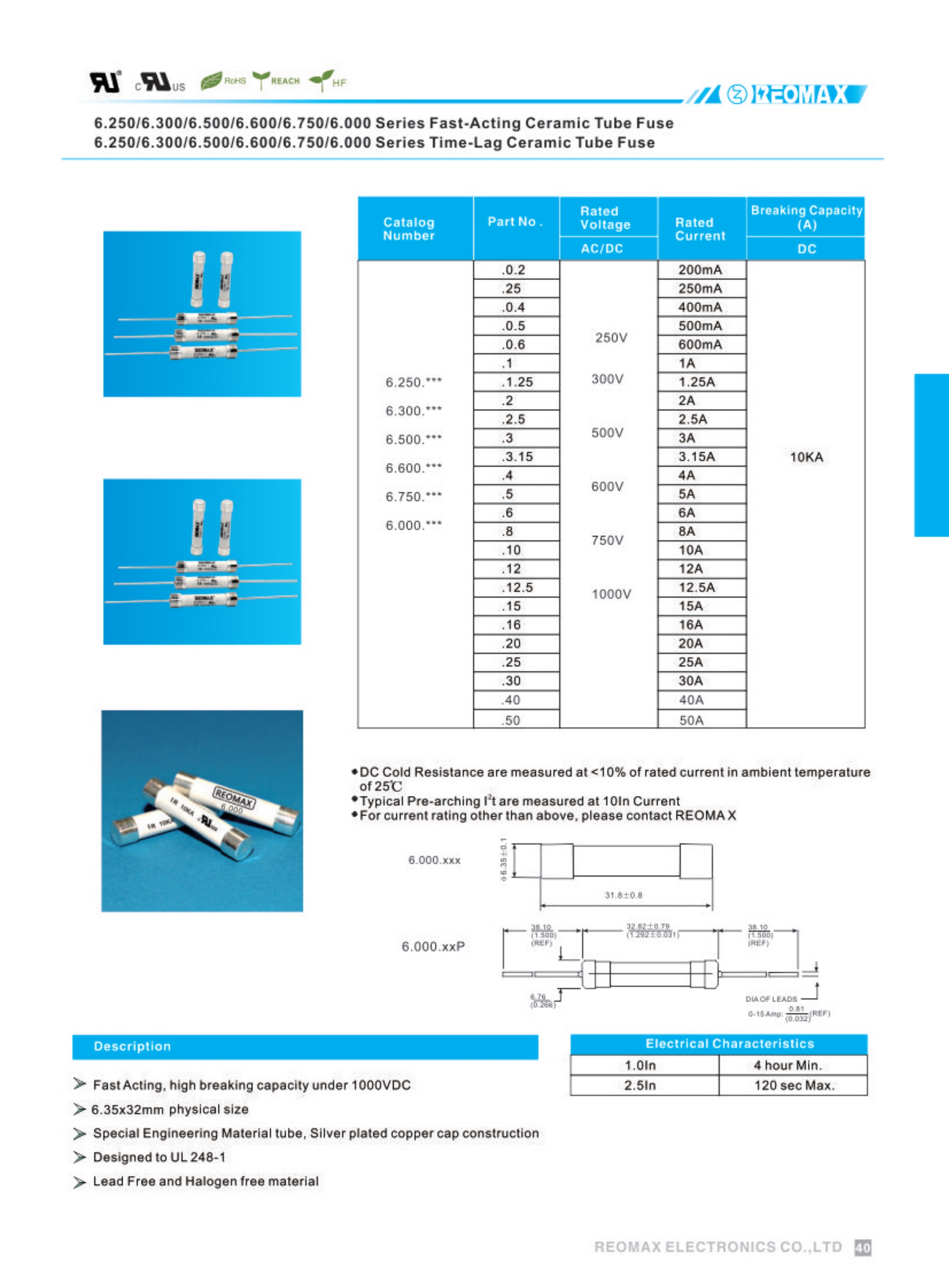6.600 Series 600V 6.35*32 High Voltage Ceramic Fuse can be divided into two types according to the installation form: with lead and without lead. The fuse tube without lead wire needs to be used together with the supporting fuse holder. The advantage of this kind of product is that when the fuse tube is damaged and the fault is eliminated, the fuse tube only needs to be reinstalled into the fuse holder, which is very convenient to replace. The disadvantage is that it needs one more process during production, and the fuse tube needs to be installed after welding the fuse holder, Therefore, in the case of the same specification, the cost of fuse without lead is slightly higher than that with lead for the first production. The early production cost of lead wire is low, only one process is required and the cost of one fuse holder is reduced. However, when the fuse tube is damaged, it needs to be replaced by professionals after disassembly, and the replacement cost is very high. Second, the fusing speed can be divided into several types according to the fusing speed: extra slow break (TT), slow break (T), medium speed (m), fast break (f) and extra fast break (FF). See i2t in the specification here. Third, breaking capacity, high breaking (H) and low breaking (L). Fourth, according to the size, it can be divided into 3.6 * 10, 4.6 * 16, 5 * 20, 6.3 * 30, etc. the specific size depends on each factory. These types of sizes are those with more consumption. Fifth: according to the classification of safety specification certification, European regulations, Japanese regulations and American regulations.
BMF series 6.35 * 32 ceramic tube quick break fuse can be divided into two types according to the installation form: with lead and without lead. The fuse tube without lead wire needs to be used together with the supporting fuse holder. The advantage of this kind of product is that when the fuse tube is damaged and the fault is eliminated, the fuse tube only needs to be reinstalled into the fuse holder, which is very convenient to replace. The disadvantage is that it needs one more process during production, and the fuse tube needs to be installed after welding the fuse holder, Therefore, in the case of the same specification, the cost of fuse without lead is slightly higher than that with lead for the first production. The early production cost of lead wire is low, only one process is required and the cost of one fuse holder is reduced. However, when the fuse tube is damaged, it needs to be replaced by professionals after disassembly, and the replacement cost is very high. Second, the fusing speed can be divided into several types according to the fusing speed: extra slow break (TT), slow break (T), medium speed (m), fast break (f) and extra fast break (FF). See i2t in the specification here. Third, breaking capacity, high breaking (H) and low breaking (L). Fourth, according to the size, it can be divided into 3.6 * 10, 4.6 * 16, 5 * 20, 6.3 * 30, etc. the specific size depends on each factory. These types of sizes are those with more consumption. Fifth: according to the classification of safety specification certification, European regulations, Japanese regulations and American regulations.
According to the protection form, it can be divided into overcurrent protection and overheating protection. The fuse used for overcurrent protection is commonly known as the fuse (also known as current limiting fuse). The fuse used for overheating protection is generally referred to as "temperature fuse". Temperature fuse is divided into low melting point alloy shape, temperature sensing trigger shape, memory alloy shape and so on (the temperature fuse is used to prevent the temperature of heating appliances or easily heating appliances from being too high, such as hair dryer, electric iron, electric rice cooker, electric furnace, transformer, motor, etc.; it responds to the temperature rise of electric appliances and does not care about the working current of the circuit. Its working principle is different from the "current limiting fuse").
According to the scope of use, it can be divided into: power fuse, machine tool fuse, electrical instrument fuse (electronic fuse) and automobile fuse.
According to the volume integral, it can be divided into: large, medium, small and micro.
According to the rated voltage, it can be divided into: high voltage fuse, low voltage fuse and safety voltage fuse.
According to breaking capacity, it can be divided into high breaking capacity fuse and low breaking capacity fuse.
According to the shape, it can be divided into: flat head tubular fuse (which can also be divided into internal welding fuse and external welding fuse), pointed tubular fuse, guillotine fuse, spiral fuse, plug-in fuse, flat fuse, wrapped fuse and patch fuse.
According to the fusing speed, it can be divided into: extra slow fuse (generally represented by TT), slow fuse (generally represented by T), medium speed fuse (generally represented by M), fast fuse (generally represented by F) and extra fast fuse (generally represented by FF).
According to the standard, it can be divided into: European fuse, American fuse and Japanese fuse.
According to the type, it can be divided into: current fuse (patch fuse, micro fuse, plug-in fuse and tubular fuse), temperature fuse (RH [block type], RP [resistance type], ry [metal shell]) and self recovery fuse (plug-in, lamination and patch).
It can be divided into: patch type 0603080512061210181220162920; non patch type Φ two point four × 7, Φ three × 8, Φ three point six × 10, Φ four point five × 15, Φ five × 20, Φ five point one six × 20, Φ six × 25, Φ six × 30, Φ six × 32, Φ eight point five × 8, Φ eight point five × eight × 4, Φ ten × 38, Φ ten × eighty-five Φ fourteen × 51。
